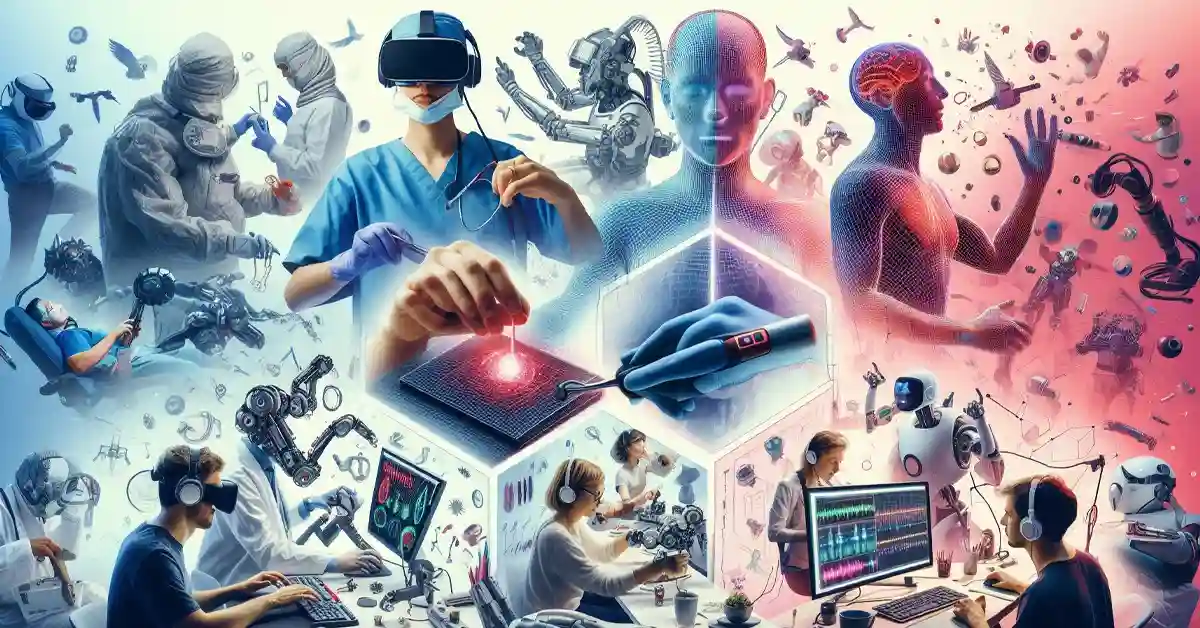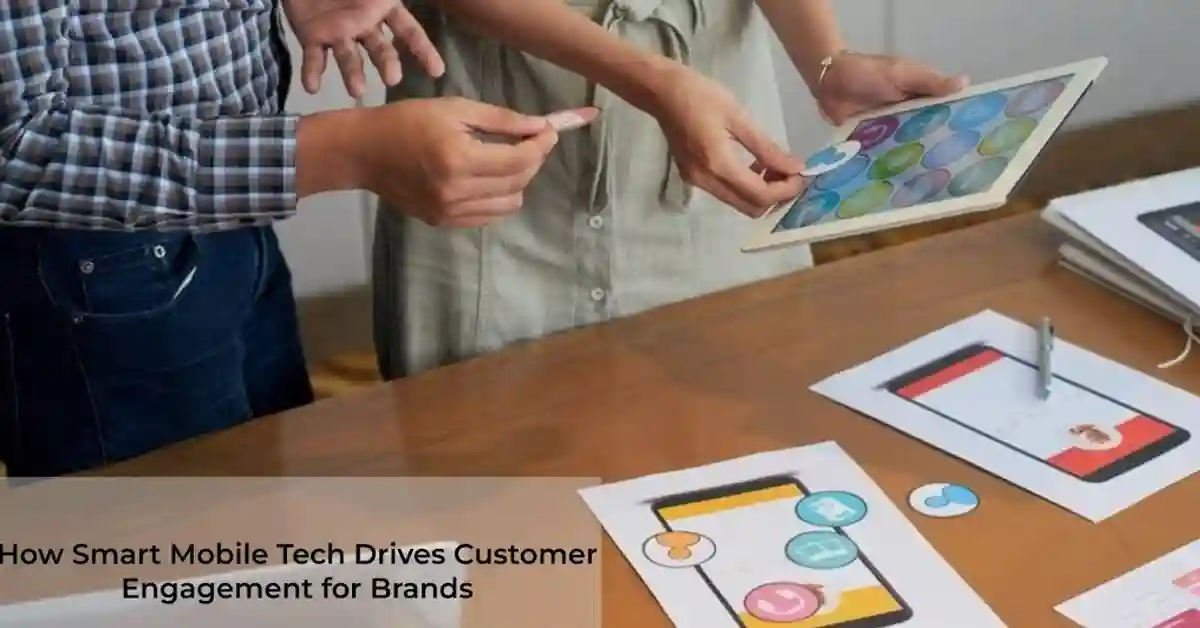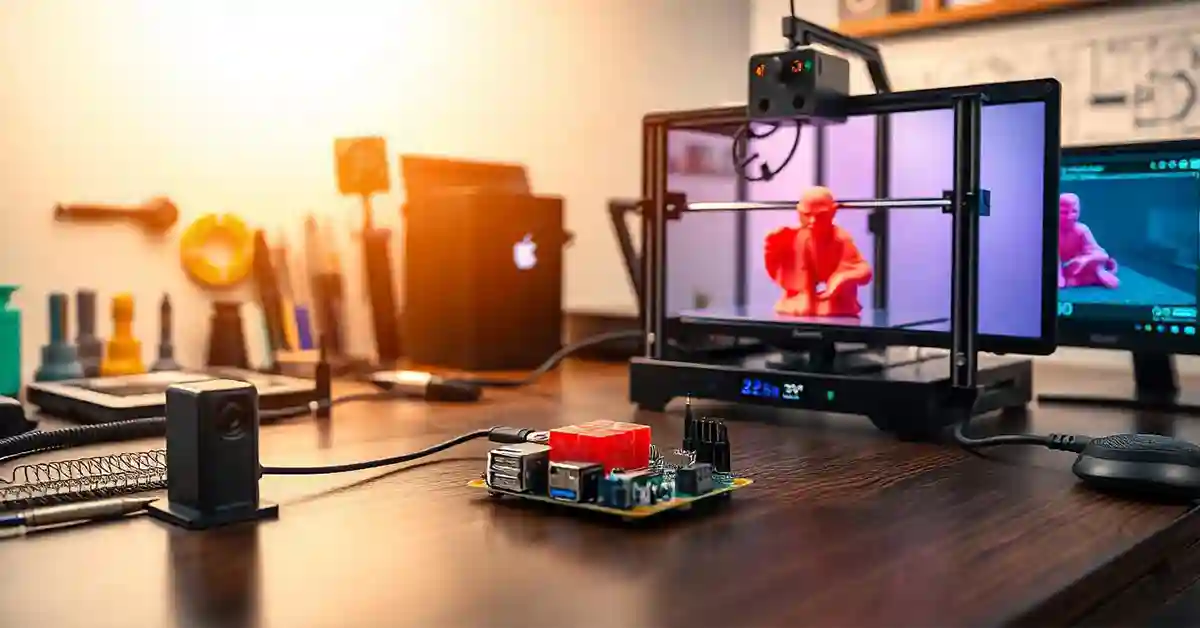Touch is one of the most important senses. We use it to connect with the world and understand our surroundings. But what if we could feel things that aren’t really there? That’s where haptic technology comes in. This incredible technology lets us experience virtual objects as if they were real.
What are applications of haptic technology? Imagine playing a video game and feeling the texture of a rough road or the impact of a crash. Or think about a surgeon performing a remote operation, feeling every movement as if they were right there. These are just some of the amazing possibilities that haptic technology offers. In this blog post, we’ll explore the many ways haptic technology is changing our lives and ask, “How can haptic technology shape the future?“
The benefits of haptic technology are immense. It improves learning, enhances virtual experiences, and makes remote work feel more connected. Keep reading to discover how this groundbreaking technology is touching every aspect of our lives.
Understanding Haptic Technology
Haptic technology, also known as tactile technology, allows users to experience the sense of touch in a digital environment. It involves using vibrations, forces, and motions to create sensations that mimic real-life touch. This technology has evolved rapidly, thanks to advances in sensors, actuators, and software.
Haptic technology works by sending signals to the skin and muscles, simulating the feeling of touching or gripping something. For example, when you press a button on your smartphone, a tiny vibration lets you know that your input was registered. This simple feedback is just the tip of the iceberg when it comes to haptic technology’s potential.
In essence, haptic technology bridges the gap between the virtual and physical worlds. It creates a more immersive and interactive experience, making digital interactions feel more natural and intuitive.
Haptic Technology in Gaming
One of the most exciting applications of haptic technology is in the gaming industry. Gamers crave immersive experiences, and haptic technology delivers just that. By incorporating haptic feedback into controllers and VR systems, developers can make games feel more realistic.
Imagine playing a racing game where you can feel the texture of the road and the vibrations of the engine. Or picture a first-person shooter where you can sense the recoil of your weapon and the impact of enemy fire. These tactile sensations add a new layer of immersion, making the gaming experience more engaging and enjoyable.
In addition to enhancing gameplay, haptic technology can also improve accessibility for gamers with disabilities. Customizable haptic feedback can help players with visual or hearing impairments experience games in new and meaningful ways.
Haptic Technology in Education
Education is another field where haptic technology is making a significant impact. Traditional learning methods often rely on visual and auditory information, but incorporating touch can enhance understanding and retention.
For example, medical students can use haptic-enabled simulators to practice surgical procedures. These simulators provide realistic feedback, allowing students to develop their skills in a safe environment. Similarly, engineering students can use haptic devices to explore complex structures and mechanisms, gaining a deeper understanding of how they work.
Haptic technology can also benefit younger students. Interactive learning tools that incorporate touch can make subjects like math and science more engaging and enjoyable. By making learning a multi-sensory experience, haptic technology helps students grasp concepts more effectively.
Haptic Technology in Healthcare
The healthcare industry is one of the most promising areas for haptic technology. Surgeons can use haptic-enabled robotic systems to perform minimally invasive procedures with greater precision. These systems provide tactile feedback, allowing surgeons to feel the resistance and texture of tissues, just as they would in a traditional operation.
Haptic technology is also being used in physical therapy and rehabilitation. Patients can use haptic devices to perform exercises that simulate real-life movements, helping them regain strength and mobility. The tactile feedback provided by these devices ensures that patients perform exercises correctly, reducing the risk of injury.
Additionally, haptic technology can improve telemedicine. Doctors can use haptic devices to examine patients remotely, feeling their pulse and assessing their condition as if they were in the same room. This capability can enhance the quality of care for patients in remote or underserved areas.
Haptic Technology in Virtual Reality
Virtual reality (VR) is all about creating immersive experiences, and haptic technology plays a crucial role in achieving this goal. By adding a sense of touch to VR environments, developers can make virtual experiences feel more lifelike.
For example, VR training programs for firefighters can incorporate haptic feedback to simulate the heat and pressure of a burning building. This realistic feedback helps trainees develop the skills and confidence they need to handle real-life emergencies. Similarly, architects can use haptic-enabled VR to walk through virtual buildings, feeling the textures and materials as if they were real.
Haptic technology also enhances entertainment experiences in VR. Whether you’re exploring a virtual world, attending a concert, or participating in a virtual workout, the sense of touch adds a new level of engagement and enjoyment.
Haptic Technology in Robotics
Robotics is another field where haptic technology is making waves. By integrating haptic feedback into robotic systems, engineers can create robots that perform delicate and precise tasks with greater accuracy.
For instance, in manufacturing, robots equipped with haptic feedback can handle fragile components without damaging them. This capability is crucial for industries like electronics and automotive manufacturing, where precision is key. Additionally, haptic-enabled robots can assist in tasks that require a human touch, such as assembling intricate devices or performing quality control inspections.
In the medical field, haptic-enabled robotic systems can assist surgeons in performing complex procedures. These systems provide the tactile feedback necessary for delicate tasks, such as suturing and tissue manipulation. By combining the strengths of human expertise and robotic precision, haptic technology is revolutionizing surgical practices.
Haptic Technology in Communication
Communication is an essential part of our daily lives, and haptic technology is enhancing the way we connect with others. By adding tactile sensations to digital communication, we can convey emotions and intentions more effectively.
For example, haptic feedback can be used in messaging apps to simulate the sensation of a gentle touch or a firm handshake. This subtle feedback adds a personal touch to digital interactions, making them feel more human. Additionally, haptic-enabled wearables can provide discreet notifications, allowing users to stay connected without constantly checking their devices.
In the realm of virtual meetings, haptic technology can enhance the sense of presence and collaboration. Participants can use haptic devices to simulate physical interactions, such as handshakes or high-fives, creating a more engaging and immersive experience.
Haptic Technology in Automotive Industry
The automotive industry is also benefiting from the integration of haptic technology. Modern vehicles are equipped with advanced infotainment systems that utilize haptic feedback to improve user interaction.
For example, touchscreen displays in cars can incorporate haptic feedback to provide tactile confirmation when a button is pressed. This feedback reduces the need for drivers to take their eyes off the road, enhancing safety. Additionally, haptic-enabled steering wheels can provide alerts and warnings, such as lane departure or collision avoidance, ensuring that drivers stay aware of their surroundings.
Haptic technology is also being used in autonomous vehicles. Passengers can interact with the vehicle’s control system through haptic interfaces, providing a more intuitive and user-friendly experience. These interfaces can simulate the sensation of controlling a traditional vehicle, giving passengers a sense of familiarity and control.
Haptic Technology in Art and Design
Artists and designers are always seeking new ways to express their creativity, and haptic technology offers exciting possibilities. By incorporating touch into digital art and design tools, creators can experience a more tactile and immersive process.
For example, digital sculptors can use haptic-enabled tools to feel the texture and resistance of virtual clay, allowing for more precise and detailed creations. Similarly, graphic designers can use haptic feedback to simulate the sensation of drawing on different surfaces, such as paper or canvas.
Haptic technology can also enhance the experience of art enthusiasts. Interactive exhibits and installations that incorporate touch can provide a deeper connection to the artwork. Visitors can feel the textures and contours of sculptures or experience the vibrations of a musical piece, creating a more engaging and memorable experience.
Haptic Technology in Sports and Fitness
Sports and fitness enthusiasts are always looking for ways to improve their performance, and haptic technology is providing valuable tools to help them achieve their goals. By incorporating touch into training and workout routines, athletes can receive real-time feedback and guidance.
For example, smart fitness equipment can use haptic feedback to correct posture and form during exercises. This feedback ensures that users perform movements correctly, reducing the risk of injury and maximizing the effectiveness of their workouts. Additionally, wearable haptic devices can provide gentle vibrations to signal when it’s time to rest or push harder, helping users stay on track.
In the world of sports, haptic technology is being used to enhance training and performance analysis. Coaches can use haptic-enabled devices to simulate game scenarios and provide players with realistic feedback. This training method helps athletes develop muscle memory and improve their skills in a controlled environment.
Haptic Technology in Accessibility
Accessibility is a crucial consideration in technology, and haptic technology is making digital experiences more inclusive for individuals with disabilities. By providing tactile feedback, haptic devices can help users with visual or hearing impairments interact with digital content.
For example, screen readers equipped with haptic feedback can convey information through vibrations and motions, allowing users to read text and navigate interfaces. This feedback provides a more intuitive and accessible experience, empowering individuals to use digital devices independently.
Haptic technology can also enhance the accessibility of public spaces. Tactile paving with haptic feedback can guide individuals with visual impairments through complex environments, ensuring their safety and independence. Additionally, haptic-enabled navigation apps can provide turn-by-turn directions through vibrations, making it easier for users to find their way.
Conclusion
Haptic technology is revolutionizing the way we interact with the digital world. From gaming and education to healthcare and communication, its applications are vast and varied. By incorporating touch into digital experiences, haptic technology creates a more immersive, engaging, and intuitive environment.
The possibilities are endless, and the impact of haptic technology will only continue to grow. Whether you’re a gamer, a student, a professional, or an artist, haptic technology has something to offer. It’s time to explore the world of haptic technology and discover how it can enhance your life.
Stay informed with the latest haptic technology news and updates. Keep an eye on emerging trends and innovations, and don’t hesitate to experiment with haptic devices in your daily activities. The future of touch is here, and it’s more exciting than ever.
What is Ancient Technology Skyrim?
Have you ever wondered what mysteries lie behind the ancient technology in Skyrim? For Skyrim enthusiasts and tech gamers, the game offers a rich tapestry of lore and hidden secrets waiting to be uncovered. Ancient technology in Skyrim isn’t just about fancy gadgets; it’s about understanding the world of the Dwemer, the ancient dwarven race that once roamed Tamriel.
What makes the ancient technology in Skyrim so fascinating? These relics are not just powerful artifacts; they hold the key to understanding the Dwemer’s advanced civilization. How do these ancient devices influence your gameplay? Can you harness their power to become invincible in this mystical world? In this blog, we will explore these questions and more. From powerful weapons to intricate puzzles, ancient technology in Skyrim adds layers of depth and excitement to your gaming experience.
Whether you’re a seasoned Skyrim veteran or a newcomer eager to learn more, this article will guide you through everything you need to know about Skyrim’s ancient technology. Discover the secrets behind these intriguing relics and how they can enhance your adventures in this expansive world.
The Enigmatic Dwemer Civilization
The Dwemer, also known as the Dwarves, are central to the ancient technology in Skyrim. Known for their advanced engineering skills, they left behind a trail of mysterious artifacts and ruins. The Dwemer civilization was highly advanced, boasting mechanical constructs and intricate machinery that still baffles scholars and adventurers alike.
Many players are intrigued by the disappearance of the Dwemer. Various theories exist, but the most popular one involves their sudden vanishing during the Battle of Red Mountain. Despite their disappearance, their legacy lives on through the incredible technology they left behind.
Exploring Dwemer ruins is a common quest in Skyrim. These locations are filled with traps, puzzles, and valuable artifacts. Venturing into these ancient sites gives players a glimpse into the Dwemer’s advanced world, making it a thrilling experience.
Ancient Technology Quest in Skyrim
One of the most engaging aspects of Skyrim’s ancient technology is its dedicated questline. The “Ancient Technology” quest involves retrieving lost Dwemer schematics for Sorine Jurard, a member of the Dawnguard. This questline adds a layer of depth to the game, encouraging players to explore Dwemer ruins and uncover lost technologies.
The quest begins when players join the Dawnguard, a faction dedicated to hunting vampires. Sorine Jurard tasks the player with finding ancient Dwemer schematics scattered across Skyrim. These schematics unlock powerful crossbow enhancements and other useful upgrades.
Completing the “Ancient Technology” quest not only rewards players with powerful upgrades but also deepens their understanding of Dwemer technology. It’s a must-do for any player looking to fully immerse themselves in Skyrim’s rich lore.
Powerful Weapons from Ancient Technology
Ancient technology in Skyrim offers some of the most powerful weapons in the game. The Dwemer were master craftsmen, creating weapons that are both deadly and beautiful. These weapons often come with unique enchantments that make them highly sought after by players.
One such weapon is the Dwarven Black Bow of Fate. This bow has a chance to absorb health, stamina, and magicka from enemies, making it incredibly versatile. Another example is the Aetherial Staff, which can summon a Dwemer automaton to fight alongside the player.
Obtaining these weapons usually involves solving complex puzzles or overcoming formidable foes. The challenge is well worth it, as these weapons can significantly enhance your combat abilities and make your adventures in Skyrim even more thrilling.
The Role of Dwarven Constructs
Dwarven constructs are mechanical beings created by the Dwemer using their advanced technology. These constructs play a significant role in Skyrim, acting as both guardians of Dwemer ruins and powerful allies for players who manage to control them.
Common Dwarven constructs include the Dwarven Spider, Dwarven Sphere, and Dwarven Centurion. Each type has its own unique abilities and weaknesses, adding variety to encounters in Dwemer ruins. For instance, Dwarven Spiders are agile and can shoot electrical bolts, while Dwarven Centurions are slow but extremely powerful.
Players can also summon Dwarven constructs using special items like the Aetherial Staff or the Dwarven Mechanism. These mechanical allies can turn the tide of battle, providing valuable support during tough encounters.
Puzzles and Challenges in Dwemer Ruins
Dwemer ruins are filled with intricate puzzles and challenges that test the player’s wits and skills. Solving these puzzles often rewards players with valuable artifacts and deeper insights into Dwemer technology.
One common puzzle involves activating a series of levers or buttons in the correct order to open doors or reveal hidden passages. Another challenge is navigating through rooms filled with deadly traps designed to deter intruders. These puzzles add an extra layer of excitement to exploring Dwemer ruins.
Successfully solving these challenges not only provides players with a sense of accomplishment but also often leads to discovering rare and powerful items. It’s a rewarding experience that encourages players to think critically and explore every nook and cranny.
The Impact of Ancient Technology on Gameplay
Ancient technology in Skyrim significantly impacts gameplay by offering unique abilities and enhancements. These technological marvels can give players an edge in combat, exploration, and even crafting.
For example, the Aetherial Crown allows players to retain the effects of two standing stones at once, providing versatile bonuses. The Enhanced Dwarven Crossbow, unlocked through the “Ancient Technology” quest, offers increased damage and armor penetration, making it a formidable weapon against tough enemies.
By incorporating ancient technology into their playstyle, players can tailor their experience to suit their preferences. Whether you prefer a stealthy approach or brute force, there’s ancient technology that can complement your strategy.
Crafting with Ancient Technology
Crafting is an essential aspect of Skyrim, and ancient technology adds a new dimension to this system. Players can use Dwemer metal and schematics to create powerful weapons, armor, and gadgets.
To craft items using ancient technology, players need to gather Dwemer metal from ruins and smelt it into ingots. These ingots can then be used to forge various items at a blacksmith’s forge. Additionally, players can find or purchase Dwemer schematics that provide blueprints for crafting unique items.
Crafting with ancient technology allows players to create gear tailored to their needs, enhancing their effectiveness in combat and exploration. It’s a rewarding system that encourages players to gather resources and experiment with different crafting recipes.
Exploring the Aetherium Forge
The Aetherium Forge is one of the most mysterious and sought-after locations in Skyrim. This ancient Dwemer forge is capable of creating powerful artifacts using Aetherium, a rare and magical material.
The quest to find the Aetherium Forge begins with the “Lost to the Ages” questline, which tasks players with finding four Aetherium Shards scattered across Skyrim. Once all the shards are collected, players can access the forge and create one of three unique items: the Aetherial Crown, Aetherial Staff, or Aetherial Shield.
Each of these items offers powerful abilities that can greatly enhance the player’s capabilities. The Aetherium Forge is a testament to the Dwemer’s advanced technology and a must-visit location for any aspiring adventurer.
Tasting the Past with Dwemer Cuisine
Believe it or not, ancient technology in Skyrim even extends to cuisine. Dwemer ruins are home to various cooking implements and recipes that provide a glimpse into the culinary habits of the Dwemer.
Players can find ancient Dwemer cooking devices such as automated food processors and pressure cookers. These tools can be used to prepare unique dishes that offer various buffs and benefits. For example, Dwemer Stew provides a significant boost to health and stamina regeneration.
Exploring Dwemer cuisine adds an extra layer of immersion to the game, allowing players to experience a taste of the past and gain valuable bonuses in the process.
The Influence of Ancient Technology on Modern Skyrim
Ancient technology has a lasting impact on the world of Skyrim, influencing various factions and individuals. Many NPCs in the game are fascinated by Dwemer technology and seek to uncover its secrets.
The Thieves Guild and the College of Winterhold both have quests involving Dwemer artifacts. These quests often involve retrieving valuable items or deciphering ancient texts. Additionally, certain NPCs, such as Calcelmo in Markarth, dedicate their lives to studying Dwemer technology and history.
The influence of ancient technology is felt throughout Skyrim, adding depth and intrigue to the game’s lore and mechanics. It serves as a reminder of the Dwemer’s lasting legacy and their impact on the world.
Conclusion
Ancient technology in Skyrim is a fascinating aspect of the game that offers endless opportunities for exploration and discovery. From powerful weapons to intricate puzzles, the remnants of the Dwemer civilization provide players with a rich and immersive experience.
Understanding and utilizing ancient technology can significantly enhance gameplay, offering unique abilities and advantages. Whether you’re crafting powerful gear, solving challenging puzzles, or uncovering hidden secrets, ancient technology adds layers of depth and excitement to your adventures in Skyrim.
Keep exploring, keep discovering, and keep pushing the boundaries of what’s possible in this incredible world. And if you’re ready to take your knowledge of ancient technology to the next level, consider joining our community of Skyrim enthusiasts. Happy adventuring!
FAQs
What is ancient technology in Skyrim?
Ancient technology in Skyrim refers to the advanced engineering and artifacts left behind by the Dwemer civilization. These include powerful weapons, mechanical constructs, and intricate puzzles.
How do I start the ancient technology quest in Skyrim?
To start the “Ancient Technology” quest, join the Dawnguard faction and speak to Sorine Jurard. She will task you with finding Dwemer schematics.
What are some powerful weapons from ancient technology in Skyrim?
Some powerful weapons include the Dwarven Black Bow of Fate and the Aetherial Staff. These weapons offer unique enchantments and abilities.
Can I craft items using ancient technology in Skyrim?
Yes, players can use Dwemer metal and schematics to craft powerful weapons, armor, and gadgets. This system allows for tailored gear that enhances combat and exploration.
What is the Aetherium Forge in Skyrim?
The Aetherium Forge is an ancient Dwemer forge capable of creating powerful artifacts using Aetherium. It can be accessed by completing the “Lost to the Ages” questline.










